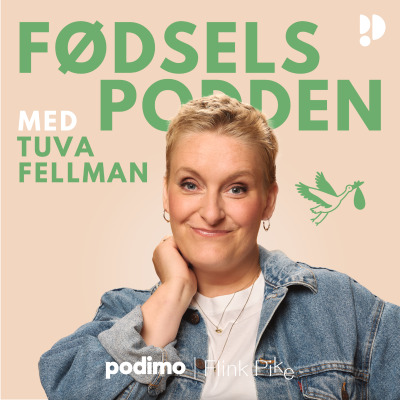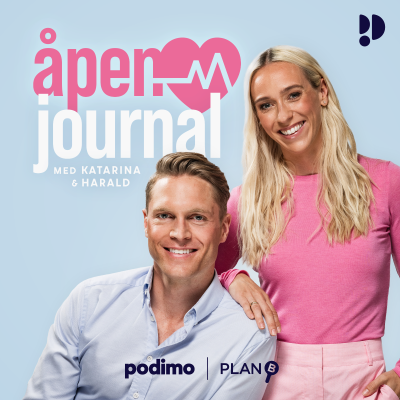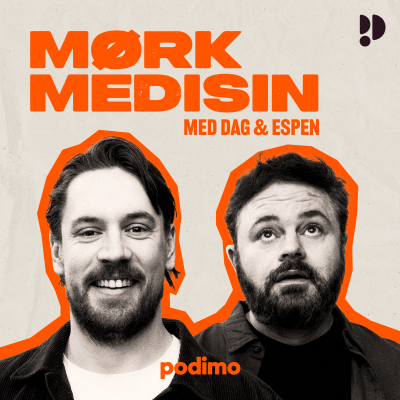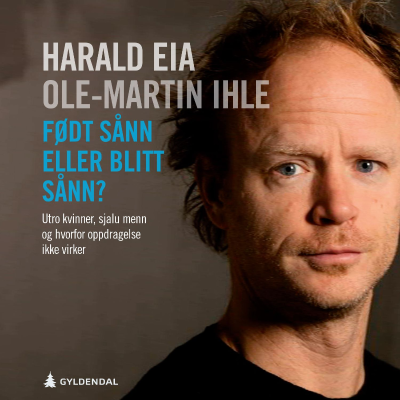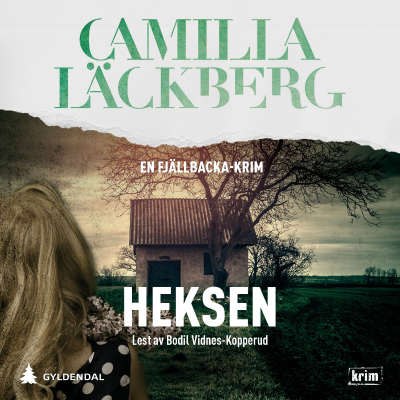
Continuum Audio
Podkast av American Academy of Neurology
Prøv gratis i 14 dager
99 kr / Måned etter prøveperioden.Avslutt når som helst.
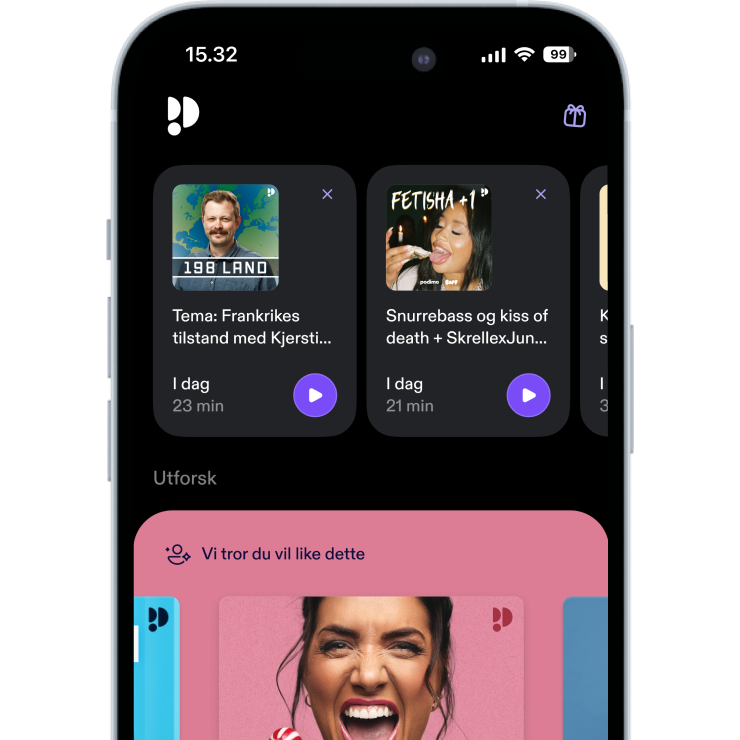
Mer enn 1 million lyttere
Du vil elske Podimo, og du er ikke alene
Rated 4.7 in the App Store
Les mer Continuum Audio
Continuum Audio features conversations with the guest editors and authors of Continuum: Lifelong Learning in Neurology, the premier topic-based neurology clinical review and CME journal from the American Academy of Neurology. AAN members can earn CME for listening to interviews for review articles and completing the evaluation on the AAN’s Online Learning Center.
Alle episoder
84 EpisoderIn this episode, Lyell K. Jones Jr, MD, FAAN, speaks with Michael S. Okun, MD, FAAN, who served as the guest editor of the August 2025 Movement Disorders issue. They provide a preview of the issue, which publishes on August 1, 2025. Dr. Jones is the editor-in-chief of Continuum: Lifelong Learning in Neurology® and is a professor of neurology at Mayo Clinic in Rochester, Minnesota. Dr. Okun is the director at Norman Fixel Institute for Neurological Diseases and distinguished professor of neurology at University of Florida in Gainesville, Florida. Additional Resources Read the issue: continuum.aan.com [https://journals.lww.com/continuum/pages/default.aspx] Subscribe to Continuum®: shop.lww.com/Continuum [https://shop.lww.com/CONTINUUM/p/1080-2371] Continuum® Aloud (verbatim audio-book style recordings of articles available only to Continuum® subscribers): continpub.com/Aloud [https://learning.aan.com/courses/107387] More about the American Academy of Neurology: aan.com [https://www.aan.com/] Social Media facebook.com/continuumcme [https://www.facebook.com/continuumcme] @ContinuumAAN [https://x.com/continuumaan?lang=en] Host: @LyellJ [https://x.com/LyellJ] Guest: @MichaelOkun [https://x.com/MichaelOkun] Full episode transcript available here: [http://continuumaudio.libsyn.com/august-2025-movement-disorders-issue-with-dr-michael-okun] Dr Jones: Our ability to move through the world is one of the essential functions of our nervous system. Gross movements like walking ranging down to fine movements with our eyes and our hands, our ability to create and coordinate movement is something many of us take for granted. So what do we do when those movements stop working as we intend? Today I have the opportunity to speak with one of the world's leading experts on movement disorders, Dr Michael Okun, about the latest issue of Continuum on Movement Disorders. Dr Jones: This is Dr Lyell Jones, Editor-in-Chief of Continuum. Thank you for listening to Continuum Audio. Be sure to visit the links in the episode notes for information about subscribing to the journal, listening to verbatim recordings of the articles, and exclusive access to interviews not featured on the podcast. Dr Jones: This is Dr Lyle Jones, Editor-in-Chief of Continuum: Lifelong Learning in Neurology. Today, I'm interviewing Dr Michael Okun, who is Continuum's guest editor for our latest issue on movement disorders. Dr Okun is the Adelaide Lackner Distinguished Professor of Neurology at the University of Florida in Gainesville, where he's also the director of the Norman Fixel Institute for Neurological Diseases. Dr Okun, welcome, and thank you for joining us today. Why don't you introduce yourselves to our listeners? Dr Okun: It's great to be here today. And I'm a neurologist. Everybody who knows me knows I'm pretty simple. I believe the patient's the sun and we should always orbit around the person with disease, and so that's how I look at my practice. And I know we always participate in a lot of research, and I've got a research lab and all those things. But to me, it's always the patients and the families first. So, it'll be great to have that discussion today. Dr Jones: Yeah, thank you for that, Dr Oaken. Obviously, movement disorders is a huge part of our field of neurology. There are many highly prevalent conditions that fit into this category that most of our listeners will be familiar with: idiopathic Parkinson's disease, essential tremor, tic disorders and so on. And having worked with trainees for a long time, it's one of the areas that I see a lot of trainees gravitate to movement disorders. And I think it's in part because of the prevalence; I think it's in part because of the diversity of the specialty with treatment options and DBS and Botox. But it's also the centrality of the neurologic exam, right? That's- the clinical examination of the patient is so fundamental. And we'll cover a lot of topics today with some questions that I have for you about biomarkers and new developments in the field. But is that your sense too, that people are drawn to just the old-fashioned, essential focus on the neurologic encounter and the neurologic exam? Dr Okun: I believe that is one of the draws to the field of movement. I think that you have neurologists from all over the world that are really interested and fascinated with what things look like. And when you see something that's a little bit, you know, off the normal road or off the normal beaten path… and we are always curious. And so, I got into movement disorders, I think, accidentally; I think even as a child, I was looking at people who had abnormal movements and tremors and I was very fascinated as to why those things happened and what's going on in the brain. And, you know, what are the symptoms and the signs. And then later on, even as my own career developed, that black bag was so great as a neurologist. I mean, it makes us so much more powerful than any of the other clinicians---at least in my biased opinion---out on the wards and out in the clinic. And, you know, knowing the signs and the symptoms, knowing how to do a neurological examination and really walking through the phenomenology, what people look like, you know, which is different than the geno- you know, the genotypes, what the genes are. What people look like is so much more important as clinicians. And so, I think that movement disorders is just the specialty for that, at least in my opinion. Dr Jones: And it helps bring it back to the patient. And that's something that I saw coming through the articles in this issue. And let's get right to it. You've had a chance to review all these articles on all these different topics across the entire field of movement disorders. As you look at that survey of the field, Dr Okun, what do you think is the most exciting recent development for patients with movement disorders? Dr Okun: I think that when you look across all of the different specialties, what you're seeing is a shift. And the shift is that, you know, a lot of people used to talk in our generation about neurology being one of these “diagnose and adios” specialties. You make the diagnosis and there's nothing that you can do, you know, about these diseases. And boy, that has changed. I mean, we have really blown it out of the water. And when you look at the topics and what people are writing about now and the Continuum issue, and we compare that the last several Continuum issues on movement disorders, we just keep accumulating a knowledge base about what these things look like and how we can treat them. And when we start thinking about, you know, all of the emergence of the autoimmune disorders and identifying the right one and getting something that's quite treatable. Back in my day, and in your day, Lyle, we saw these things and we didn't know what they were. And now we have antibodies, now we can identify them, we can pin them down, and we can treat many of them and really change people's lives. And so, I'm really impressed at what I see in changes in identification of autoimmune disorders, of channelopathies and some of the more rare things, but I'm also impressed with just the fundamental principles of how we're teaching people to be better clinicians in diseases like Parkinson’s, Huntington's, ataxia, and Tourette. And so, my enthusiasm for this issue of Continuum is both on, you know, the cutting edge of what we're seeing based on the identification on our exams, what we can do for these people, but also the emergence of how we're shifting and providing much better care across a continuum for folks with basal ganglia diseases. Dr Jones: Yeah, I appreciate that perspective, Dr Okun. One of the common themes that I saw in the issue was with these new developments, right, when you have new tools like new diagnostic biomarker tools, is the question of if and when and how to integrate those into daily clinical practice, right? So, we've had imaging biomarkers for a while, DAT scans, etc. For patients with idiopathic Parkinson disease, one of the things that I hear a lot of discussion and controversy about are the seed amplification assays as diagnostic biomarkers. What can you tell us about those? Are those ready for routine clinical use yet? Dr Okun: I think the main bottom-line point for folks that are out there trying to practice neurology, either in general clinics or even in specialty clinics, is to know that there is this movement toward, can we biologically classify a disease? One of the things that has, you know, really accelerated that effort has been the development of these seed amplification assays, which---in short for people who are listening---are basically, we “shake and bake” these things. You know? We shake them for like 20 hours and we use these prionlike proteins, and we learn from diseases like prion disease how to kind of tag these things and then see, do they have degenerative properties? And in the case of Parkinson's disease, we're able to do this with synuclein. That is the idea of a seed amplification assay. We're able to use this to see, hey, is there synuclein present or not in this sample? And people are looking at things like cerebrospinal fluid, they're looking at things like blood and saliva, and they're finding it. The challenge here is that, remember- and one of the things that's great about this issue of Continuum is, remember, there are a whole bunch of different synucleinopathies. So, Dr Jones, it isn't just Parkinson's disease. So, you've got Parkinson's disease, you've got Lewy body, you know, and dementia with Lewy bodies. You've got, you know, multiple system atrophy is within that synucleinopathy, you know, group primary autonomic failure… so not just Parkinson's disease. And so, I think we have to tap the brakes as clinicians and just say, we are where we are. We are moving in that direction. And remember that a seed amplification assay gives you some information, but it doesn't give you all the information. It doesn't forgive you looking at a person over time, examining them in your clinic, seeing how they progress, seeing their response to dopamine- and by the way, several of these genes that are associated with Parkinson; and there's, you know, less than 20% of Parkinson is genetic, but several of these genes, in a solid third---and in some cases, in some series, even more---miss the synuclein assay, misses, you know, the presence of a disease like Parkinson's disease. And so, we have to be careful in how we interpret it. And I think we're more likely to see over time a gemish: we're going to smush together all this information. We're going to get better with MRIs. And so, we're actually doing much better with MRIs and AI-based intelligence. We've got DAT scans, we've got synuclein assays. But more than anything, everybody listening out there, you can still examine the person and examine them over time and see how they do over time and see how they do with dopamine. And that is still a really, really solid way to do this. The synuclein assays are probably going to be ready for prime time more in choosing and enriching clinical trials populations first. And you know, we're probably 5, 10 years behind where Alzheimer's is right now. So, we'll get there at some point, but it's not going to be a silver bullet. I think we're looking at these are going to be things that are going to be interpreted in the context for a clinician of our examination and in the context of where the field is and what you're trying to use the information for. Dr Jones: Thank you for that. And I think that's the general gestalt I got from the articles and what I hear from my colleagues. And I think we've seen this in other domains of neurology, right? We have the specificity and sensitivity issues with the biomarkers, but we also have the high prevalence of copathology, right? People can have multiple different neurodegenerative problems, and I think it gets back to that clinical context, like you said, following the patient longitudinally. That was a theme that came out in the idiopathic Parkinson disease article. And while we're on Parkinson disease, you know, the first description of that was what, more than two hundred years ago. And I think we're still thinking about the pathophysiology of that disorder. We understand risk factors, and I think many of our listeners would be familiar with those. But as far as the actual cause, you know, there's been discussion in recent years about, is there a role of the gut microbiome? Is this a prionopathic disorder? What's your take on all of that? Dr Okun: Yeah, so it's a great question. It's a super-hot area right now of Parkinson. And I kind of take this, you know, apart in a couple of different ways. First of all, when we think about Parkinson disease, we have to think upstream. Like, what are the cause and causes? Okay? So, Parkinson is not one disease, okay? And even within the genes, there's a bunch of different genes that cause it. But then we have to look and say, well, if that's less than 20% depending on who's counting, then 80% don't have a single piece of DNA that's closely associated with this syndrome. And so, what are we missing with environment and other factors? We need to understand not what happens at the end of the process, not necessarily when synuclein is clumping- and by the way, there's a lot of synuclein in the brains normally, and there's a lot of Tau in people's brains who have Parkinson as well. We don't know what we don't know, Dr Jones. And so when we begin to think about this disease, we've got to look upstream. We've got to start to think, where do things really start? Okay? We've got to stop looking at it as probably a single disease or disorder, and it's a circuit disorder. And then as we begin to develop and follow people along that pathway and continuum, we're going to realize that it's not a one-size-fits-all equation when we're trying to look at Parkinson. By the way, for people listening, we only spend two to three cents out of every dollar on prevention. Wouldn't prevention be the best cure, right? Like, if we were thinking about this disease. And so that's something that we should be, you know, thinking about. And then the other is the Global Burden of Disease study. You know, when we wrote about this in a book called Ending Parkinson's Disease, it looked like Parkinson's was going to double by 2035. The new numbers tell us it's almost double to the level that we expected in 2035 in this last series of numbers. So, it's actually growing much faster. We have to ask why? Why is it growing faster? And then we have lots of folks, and even within these issues here within Continuum, people are beginning to talk about maybe these environmental things that might be blind spots. Is it starting in our nose? Is it starting in our gut? And then we get to the gut question. And the gut question is, if we look at the microbiomes of people with Parkinson, there does seem to be, in a group of folks with Parkinson, a Parkinson microbiome. Not in everyone, but if you look at it in composite, there seems to be some clues there. We see changes in Lactobacillus, we see some bacteria going up that are good, some bacteria going down, you know, that are bad. And we see flipping around, and that can change as we put people on probiotics and we try to do fecal microbiota transplantations- which, by the way, the data so far has not been positive in Parkinson's. Doesn't mean we might not get there at some point, but I think the main point here is that as we move into the AI generation, there are just millions and millions and millions of organisms within your gut. And it's going to take more than just our eyes and just our regular arithmetic. You and I probably know how to do arithmetic really well, but this is, like, going to be a much bigger problem for computers that are way smarter than our brains to start to look and say, well, we see the bacteria is up here. That's a good bacteria, that's a good thing or it's down with this bacteria or this phage or there's a relationship or proportion that's changing. And so, we're not quite there. And so, I always tell people---and you know, we talk about the sum in the issue---microbiomes aren't quite ready for prime time yet. And so be careful, because you could tweak the system and you might actually end up worse than before you started. So, we don't know what we don't know on this issue. Dr Jones: And that's a great point. And one of the themes they're reading between the lines is, we will continue to work on understanding the bio-pathophysiology, but we can't wait until that day to start managing the risk factors and treating patients, which I think is a good point. And if we pivot to treatment here a little bit, you know, one of the exciting areas of movement disorders---and really neurology broadly, I think movement disorders has led the field in many ways---is bioelectronic therapy, or what one of my colleagues taught me is “electroceutical therapy”, which I think is a wonderful term. Dr Okun, when our listeners are hearing about the latest in deep brain stimulation in patients who have movement disorders, what should they know? What are the latest developments in that area with devices? Dr Okun: Yeah. So, they should know that things are moving rapidly in the field of putting electricity into the brain. And we're way past the era where we thought putting a little bit of electricity was snake oil. We know we can actually drive these circuits, and we know that many of these disorders---and actually, probably all of the disorders within this issue of Continuum---are all circuit disorders. And so, you can drive the circuit by modulating the circuit. And it's turned out to be quite robust with therapies like deep brain stimulation. Now, we're seeing uses of deep brain stimulation across multiple of these disorders now. So, for example, you may think of it in Parkinson's disease, but now we're also seeing people use it to help in cases where you need to palliate very severe and bothersome chorea and Huntington's disease, we're seeing it move along in Tourette syndrome. We of course have seen this for various hyperkinetic disorders and dystonias. And so, the main thing for clinicians to realize when dealing with neuromodulation is, take a deep breath because it can be overwhelming. We have a lot of different devices in the marketplace and no matter how many different devices we have in the marketplace, the most important thing is that we get the leads. You know, where we're stimulating into the right location. It's like real estate: location, location, location, whether you've got a lead that can steer left, right, up, down and do all of these things. Second, if you're feeling overwhelmed because there are so many devices and so many settings, especially as we put these leads in and they have all sorts of different, you know, nodes on them and you can steer this way and that way, you are not alone. Everybody is feeling that way now. And we're beginning to see AI solutions to that that are going to merge together with imaging, and then we're moving toward an era of, you know, should I say things like robotic programming, where it's going to be actually so complicated as we move forward that we're going to have to automate these systems. There's no way to get this and scale this for all of the locales within the United States, but within the entire world of people that need these types of devices and these therapies. And so, it's moving rapidly. It's overwhelming. The most important thing is choosing the right person. Okay? For this, with multidisciplinary teams, getting the lead in the right place. And then all these other little bells and whistles, they're like sculpting. So, if you think of a sculpture, you kind of get that sculpture almost there. You know, those little adds are helping to maybe make the eyes come out a little more or the facial expression a little bit better. There's little bits of sculpting. But if you're feeling overwhelmed by it, everybody is. And then also remember that we're starting to move towards some trials here that are in their early stages. And a lot of times when we start, we need more failures to get to our successes. So, we're seeing trials of people looking at, like, oligo therapies and protein therapies. We're seeing CRISPR gene therapies in the laboratory. And we should have a zero tolerance for errors with CRISPR, okay? we still have issues with CRISPR in the laboratory and which ones we apply it to and with animals. But it's still pretty exciting when we're starting to see some of these therapies move forward. We're going to see gene therapies, and then the other thing we're going to see are nano-therapies. And remember, smaller can be better. It can slip across the blood brain barrier, you have very good surface area-to-volume ratios, and we can uncage drugs by shining things like focused ultrasound beams or magnets or heat onto these particles to turn them on or off. And so, we're seeing a great change in the field there. And then also, I should mention: pumps are coming and they're here. We're getting pumps like we have for diabetes and neurology. It's very exciting. It's going to be overwhelming as everybody tries to learn how to do this. So again, if you're feeling overwhelmed, so am I. Okay? But you know, pumps underneath the skin for dopamine, pumps underneath the skin for apomorphine. And that may apply to other disorders and not just Parkinson as we move along, what we put into those therapies. So, we're seeing that age come forward. And then making lesions from outside the brain with focused ultrasound, we're starting to get better at that. Precision is less coming from outside the brain; complications are also less. And as we learn how to do that better, that also can provide more options for folks. So, a lot of things to read about in this issue of Continuum and a lot of really interesting and beyond, I would say, you know, the horizon as to where we're headed. Dr Jones: Thank you for that. And it is a lot. It can be overwhelming, which I guess is maybe a good reason to read the issue, right? I think that's a great place to end and encourage our listeners to pick up the issue. And Dr Okun, I want to thank you for joining us today. Thank you for such a great discussion on movement disorders. I learned a lot. I'm sure our listeners will as well, given the importance of the topic, your leadership in the field over many years. I'm grateful that you have put this issue together. So, thank you. And you're a busy person. I don't know how we talked you into doing this, but I'm really glad that we did. Dr Okun: Well, it's been my honor. And I just want to point out that the whole authorship panel that agreed to write these articles, they did all the work. I'm just a talking head here, you know, telling you what they did, but they're writing, and the people that are in the field are really, you know, leading and helping us to understand, and have really put it together in a way that's kind of helped us to be better clinicians and to impact more lives. So, I want to thank the group of authors, and thank you, Dr Jones. Dr Jones: Again, we've been speaking with Dr Michael Okun, guest editor of Continuum's most recent issue on movement disorders. Please check it out. And thank you to our listeners for joining today. Dr Monteith: This is Dr Teshamae Monteith, Associate Editor of Continuum Audio. If you've enjoyed this episode, you'll love the journal, which is full of in-depth and clinically relevant information important for neurology practitioners. Use the link in the episode notes to learn more and subscribe. Thank you for listening to Continuum Audio.
With the increase in the public’s attention to all aspects of brain health, neurologists need to understand their role in raising awareness, advocating for preventive strategies, and promoting brain health for all. To achieve brain health equity, neurologists must integrate culturally sensitive care approaches, develop adapted assessment tools, improve professional and public educational materials, and continually innovate interventions to meet the diverse needs of our communities. In this BONUS episode, Casey Albin, MD, speaks with Daniel José Correa, MD, MSc, FAAN and Rana R. Said, MD, FAAN, coauthors of the article “Bridging the Gap Between Brain Health Guidelines and Real-world Implementation” in the Continuum® June 2025 Disorders of CSF Dynamics issue. Dr. Albin is a Continuum® Audio interviewer, associate editor of media engagement, and an assistant professor of neurology and neurosurgery at Emory University School of Medicine in Atlanta, Georgia. Dr. Correa is the associate dean for community engagement and outreach and an associate professor of neurology at the Albert Einstein College of Medicine Division of Clinical Neurophysiology in the Saul Korey Department of Neurology at the Montefiore Medical Center, New York, New York. Dr. Said is a professor of pediatrics and neurology, the director of education, and an associate clinical chief in the division of pediatric neurology at the University of Texas Southwest Medical Center in Dallas, Texas. Additional Resources Read the article: Bridging the Gap Between Brain Health Guidelines and Real-world Implementation [https://journals.lww.com/continuum/fulltext/2025/06000/bridging_the_gap_between_brain_health_guidelines.15.aspx] Subscribe to Continuum®: shop.lww.com/Continuum [https://shop.lww.com/CONTINUUM/p/1080-2371] Continuum® Aloud (verbatim audio-book style recordings of articles available only to Continuum® subscribers): continpub.com/Aloud [https://learning.aan.com/courses/105889/audio_presentations/358585] More about the American Academy of Neurology: aan.com [https://www.aan.com/] Social Media facebook.com/continuumcme [https://www.facebook.com/continuumcme] @ContinuumAAN [https://x.com/continuumaan?lang=en] Host: @caseyalbin [https://x.com/caseyalbin?ref_src=twsrc%5Egoogle%7Ctwcamp%5Eserp%7Ctwgr%5Eauthor] Guests: @NeuroDrCorrea [https://x.com/NeuroDrCorrea], @RanaSaidMD [https://x.com/RanaSaidMD] Full episode transcript available here [https://continuumaudio.libsyn.com/bonus-episode-bridging-the-gap-between-brain-health-guidelines-and-real-world-implementation-with-drs-daniel-correa-and-rana-said] Dr Jones: This is Dr Lyell Jones, Editor-in-Chief of Continuum. This exclusive Continuum Audio interview is available only to you, our subscribers. We hope you enjoy it. Thank you for listening. Dr Albin: Hi all, this is Dr Casey Albin. Today I'm interviewing Dr Daniel Correa and Dr Rana Said about their article on bridging the gap between brain health guidelines and real-world implementation, which they wrote with Dr Justin Jordan. This article appears in the June 2025 Continuum issue on disorders of CSF dynamics. Thank you both so much for joining us. I'd love to just start by having you guys introduce yourselves to our listeners. Rana, do you mind going first? Dr Said: Yeah, sure. Thanks, Casey. So, my name is Rana Said. I'm a professor of pediatrics and neurology at the University of Texas Southwestern Medical Center in Dallas. Most of my practice is pediatric epilepsy. I'm also the associate clinical chief and the director of education for our division. And in my newer role, I am the vice chair of the Brain Health Committee for the American Academy of Neurology. Dr Albin: Absolutely. So just the right person to talk about this. And Daniel, some of our listeners may know you already from the Brain and Life podcast, but please introduce yourself again. Dr Correa: Thank you so much, Casey for including us and then highlighting this article. So yes, as you said, I'm the editor and the cohost for the Brain and Life podcast. I do also work with Rana and all the great members of the Brain Health Initiative and committee within the AAN, but in my day-to-day at my institution, I'm an associate professor of neurology at the Albert Einstein College of Medicine in the Montefiore Health System. I do a mix of general neurology and epilepsy and with a portion of my time, I also work as an associate Dean at the Albert Einstein College of Medicine, supporting students and trainees with community engagement and outreach activities. Dr Albin: Excellent. Thank you guys both so much for taking the time to be here. You know, brain health has really become this core mission of the AAN. Many listeners probably know that it's actually even part of the AAN’s mission statement, which is to enhance member career fulfillment and promote brain health for all. And I think a lot of us have this kind of, like, vague idea about what brain health is, but I'd love to just start by having a shared mental model. So, Rana, can you tell us what do you mean when you talk about brain health? Dr Said: Yeah, thanks for asking that question. And, you know, even as a group, we really took quite a while to solidify, like, what does that even mean? Really, the concept is that we're shifting from a disease-focused model, which we see whatever disorder comes in our doors, to a preventative approach, recognizing that there's a tremendous interconnectedness between our physical health, our mental health, cognitive and social health, you know, maintaining our optimal brain function. And another very important part of this is that it's across the entire lifespan. So hopefully that sort of solidifies how we are thinking about brain health. Dr Albin: Right. Daniel, anything else to add to that? Dr Correa: One thing I've really liked about this, you know, the evolution of the 2023 definition from the AAN is its highlight on it being a continuous state. We're not only just talking about prevention of injury and a neurologic condition, but then really optimizing our own health and our ability to engage in our communities afterwards, and that there's always an opportunity for improvement of our brain health. Dr Albin: I love that. And I really felt like in this article, you walked us through some tangible pillars that support the development and maintenance of this lifelong process of maintaining and developing brain health. And so, Daniel, I was wondering, you know, we could take probably the entire time just to talk about the five pillars that support brain health. But can you give us a pretty brief overview of what those are that you outlined in this article? Dr Correa: I mean, this was one of the biggest challenges and really bundling all the possibilities and the evidence that's out there and just getting a sense of practical movement forward. So, there are many organizations and groups out there that have formed pillars, whether we're calling them seven or eight, you know, the exact number can vary, but just to have something to stand on and move forward. We've bundled one of them as physical and sleep health. So really encouraging towards levels of activity and not taking it as, oh, that there's a set- you know, there are recommendations out there for amount of activity, but really looking at, can we challenge people to just start growing and moving forward at their current ability? Can we challenge people to look at their sleep health, see if there's an aspect to improve, and then reassess with time? We particularly highlight the importance of mental health, whether it's before a neurologic condition or a brain injury occurs or addressing the mental health comorbidities that may come along with neurologic conditions. Then there's of course the thing that everyone thinks about, I think, with brain health in terms of is cognitive health. And you know, I think that's the first place that really enters either our own minds or as we are observers of our elder individuals in our family. And more and more there has been the highlight on the need for social interconnectedness, community purpose. And this is what we include as a pillar of social health. And then across all types of neurologic potential injuries is really focusing on the area of brain injury. And so, I think the area that we've often been focused as neurologists, but also thinking of both the prevention along with the management of the condition or the injury after it occurs. Dr Albin: Rana, anything else to add to that? That’s a fantastic overview. Dr Said: Daniel, thank you for- I mean, you just set it up so beautifully. I think the other thing that maybe would be important for people to understand is that as we're talking through a lot of these, these are individual. These sound like very individual-basis factors. But as part of the full conversation, we also have to understand that there are some factors that are not based on the individual, and then that leads to some of the other initiatives that we'll be talking about at the community and policy levels. So, for example, if an individual is living in an area with high air pollution. Yes, we want them to be healthy and exercise and sleep, but how do we modify those factors? What about lead leaching from our aging pipes or even infectious diseases? So, I think that outside of our pillars, this is sort of the next step is to understand what is also at large in our communities. Dr Albin: That's a really awesome point. I love that the article really does shine through and that there are these individual factors, and then there there's social factors, there’s policy factors. I want to start just with that individual because I think so many of our patients probably know, like, stress management, exercise, sleep, all of that stuff is really important. But when I was reading your article, what was not so obvious to me was, what's the role that we as neurologists should play in advocating? And really more importantly, like, how should we do that? And again, it struck me that there are these kind of two issues at play. And one is that what Daniel was saying that, you know, a lot of our patients are coming because they have a problem, right? We are used to operating in this disease-based care, and there's just limited time, competing clinical demands. If they're not coming to talk about prevention, how do we bring that in? And so Rana, maybe I'll start with you just for that question, you know, for the patients who are seeing us with a disease complaint or they're coming for the management of a problem, how are you organizing this at the bedside to kind of factor in a little bit about that preventative brain health? Dr Said: You know, I think the most important thing at the bedside is, one, really identifying the modifiable risk factors. These have been well studied, we understand them. Hypertension, diabetes, smoking, weight management. And we know that these definitely are correlative. So is it our role just to talk about stroke, or should we talk about, how are you managing your blood pressure? Health education, if there was one major cornerstone, is elevating health literacy for everyone and understanding that patients value clear and concise information about brain health, about modifiable risk factors. And the corollary to that, of course, are what are the resources and services? I completely understand---I'm a practicing clinician---the constraints that we have at the bedside, be it in the hospital or in our clinics. And so being the source of information, how are we referring our families and individuals to social workers, community health worker support, and really partnering with them, food banks, injury prevention programs, patient advocacy organizations? I think those are really ways that we can meet the impacts that we're looking at the bedside that can feel very tangible and practical. Dr Albin: That's really excellent advice. And so, I'd like to ask a follow-up question. With your knowledge of this, trying to get more multidisciplinary buy-in from your clinic so that you really have the support to get these services that are so critically important. And how do you do that? Dr Said: Yeah, I think it's, one, being a champion. So, what does a champion mean? It means that somebody has to decide this is really important. And I think we all realize that we're not the only ones in the room who care about this. We're all in this, and we all care about it. But how do we champion it and carry it through? And so that's the first. Second you find your partnerships: your social workers, your case managers, your other colleagues. And then what is the first-level entry thing that you can do? So for example, I'm a pediatric epileptologist. One of the things we know is that in pediatric epilepsy, depression and anxiety are very strong comorbidities. So, before we get to the point where a child is in distress, every single one of our epilepsy patients who walks in the door over the age of twelve has an age-appropriate screener that is given to them in both English and Spanish. And we assess it and we determine stratifying risk. And then we have our social workers on the back end and we decide, is this a child who needs resources? Is this a child who needs to be walked to the emergency room, escorted? And anything in between. And I think that that was a just a very tangible example of, every single person can do this and ask about it. And through the development of dot phrases and clear protocols, it works really well. Dr Albin: I love that, the way that you're just being mindful. At every step of the way, we can help people towards this lifelong brain health. And Daniel, you work with an adult population. So I wonder, what are your tips for bringing this to a different patient population? Dr Correa: Well, I think---adult or child---one thing that we often are aware of with so many of the other things that we're doing in bedside or clinic room counseling, but we don't necessarily think of in this context of brain health, is, remember all the people in the room. So, at the bedside, whether it's in the ICU, discharge counseling, the initial admission, the whole family is often involved and really concerned about the active issue. But you can look for opportunities- we often try to counsel and support families about the importance of their own sleep and rest and highlighting it not just as being there for their family member, but highlighting it to them as a measure of their own improvement of their brain health. So, looking at ways where, one, I try to find, is there something I can do to support and educate the whole family about their brain health? And then- and with an epilepsy, or in many other situations, I try to look for one comorbidity that might be a pillar of brain health to address that maybe I wasn't already thinking. And then I consider, is there an additional thing that they wouldn't naturally connect to their epilepsy or their headaches that I can bring in for them to work on? You know, we can't often give people twelve different things to work on, and they’d just feel like, okay like, you have no realistic understanding of my life. But if we can just highlight on one, and remind them that there can be many more ways to improve their health and to follow up either with us as their neurologist or their future primary care doctors to address those additional needs. Again, I would really highlight the importance of a multidisciplinary approach and looking for opportunities. We've too often, I feel, relied on primary care as being the first line for addressing unmet social health needs. We know that so many people, once they have a neurologic condition or the potential, even, of a neurologic condition, they're concerned about dementia or something, they may view us, as their neurologist, as their most important provider. And if they don't have the resource of time and money to show up at other doctors, we may be the first one they're coming to. And so, tapping into your institution's resources and finding out, are there things that are available to the primary care services that for some reason we're not able to get on the inpatient side or the outpatient side? Referring to social workers and care workers and showing that our patients have an independent need, that they're not somehow getting captured by the primary care doctors. Dr Albin: I really love that. I think that we- just being more invested and just being ready to step into that role is really important. I was noticing in this article, you really call that being a brain health ambassador, being really mindful, and I will direct all of our listeners to Figure 3, which really captures what practitioners can do both at the bedside, within their local community, and even at the professional society level, to really advocate for policies that promote brain wellness. Rana, at the very beginning of this conversation, you noted, you know, this is not just an individual problem. This really is something that is a component of our policy and the structure of our local communities. I really loved in the article, there's a humility that this cannot be just a person-by-person bedside approach, that this is a little bit determined by the social determinants of health. And so, Rana, can you walk us through a little bit of what are the social determinants of health, and why are these so crucially important when we think about brain health for all? Dr Said: Yeah, social determinants of health are a really key factor that it looks at, what are the health factors that are environmental; for example, that are not directly like what your blood pressure is, what, you know, what your BMI is, that definitely impact our health outcomes. So, these include environmental things like where people are born, where they live, where they learn, work, play, worship, and age. It encompasses factors like your socioeconomic status, your education, the neighborhoods where you are living, definitely healthcare access. And then all of this is in a social and community context. We know that the impact of social determinants of health on brain health are profound for the entire lifespan and that- so, for example, if someone is from a disadvantaged background or that leads to chronic stress, they can have limited access to healthcare. They can have greater risk of exposure to, let's say, environmental toxins, and all of that will shape how their brain health is. Violence, for example. And so, as we think about how we're going to target and enhance brain health, we really have to understand that these are vulnerable populations, special high-risk populations, that often have a disproportionate burden of neurologic disorders. And by identifying them and then developing targeted interventions, it promotes health equity. And it really has to be done in looking at culturally- ethnocultural-sensitive healthcare education resources, thinking about culturally sensitive or adaptive assessment tools that work for different populations so that these guidelines that we have, that we've already identified as being so valuable, can be equitably applied, which is one crucial component of reducing brain health risk factors. And lastly, at the neighborhood level, this is where we really rely on our partnerships with community partners who really understand their constituents and they understand how to have the special conversations, how to enhance brain health through resource utilization. And so, this is another plug for policy and resources. Dr Albin: I love that. And thinking about the neighborhood and the policy levels and all the things that we have to do. Daniel, I'd like to ask you, is there anything else you would add? Dr Correa: Yeah, you know, so I really wanted to come back to this thing is that often and unfortunately, in the beginning understanding of social determinants of health, they're thought of as a positive or a negative factor, and often really negative. These are just facts. They're aspects about our community, our society, and some of them may be at the individual level. They're not at fault of any individual or community, or even our society. They're just the realities. And when someone has a factor that may predict a health disparity or an unmet social need---I wanted to come back to that concept and that term---one or two positive factors that are social determinants of health for that individual are unmet social needs. It's a point of promise. It's a potential to be addressed. And seeking ways to connect them with community services, social work, caregivers, these are ways where- that we can remove a barrier to, so that the possibility of the recommendations that we're used to doing, giving recommendations about medications and management, can be fully appreciated for that person. And the other aspect is, like brain health, this is a continuous state. The social determinants of health may be different for the child, the parent, and the elderly family member in the household, and there might be some that are shared across them. And when one of those individuals has a new medical illness or a new condition, a stroke, and now has a mobility limitation, that may change a social determinant of health for that person or for anyone else in the family, the other people now becoming caregivers. We're used to this. And for someone after a stroke or traumatic brain injury, now they have mobility changes. And so, we work on addressing those. But thinking on how those things now become a barrier for engaging with community and accessing things, something as simple as their pharmacy. Dr Albin: I hear a lot of “this is a fluid situation,” but there's hope here because these are places that we can intervene and that we can really champion brain health throughout this fluid situation. Which kind of brings me to what we're going to close out with, which is, I'm going to have you do a little thought exercise, which is that you find a magic lamp and a genie comes out. And we'll call this the brain health genie. The genie says that they are going to grant you one wish for the betterment of brain health. Daniel, I'll start with you. What is the one thing that you think could really move the needle on promoting and maintaining brain health? Dr Correa: I will jump on nutrition and food access. If we could somehow get rid of food insecurity and have access to whole and fresh foods for everyone, and people could go back to looking at opportunities from their ancestral and cultural experiences to cook and make whole-food recipes from their own cultures. Using something like the Mediterranean diet and the mind diet as a framework, but not looking at those as cultural barriers that we somehow all have to eat a certain way. So, I think that would really be the place I would go to first that would improve all of our brain health. Dr Albin: I love that. So, wholesome eating. Rana, how about you? One magic wish. Dr Said: I think traumatic brain injury prevention. I think it's so- it feels so within our reach, and it just always is so heart-hurting when you think that wearing helmets, using seatbelts, practicing safety in sports, gun safety---because we know unfortunately that in pediatric patients, firearm injury is the leading cause of traumatic brain injury. In our older patients, fall reduction. If we could figure out how to really disseminate the need for preventative measures, get everyone really on board, I think this is- the genie wouldn't have to work too hard to make that one come true. Dr Albin: I love that. As a neurointensivist, I definitely feel that TBI prevention. We could talk about this all day long. I really wish we had a longer bit of time, but I really would direct all of our listeners to this fantastic article where you give really practical advice. And so again, today I've been interviewing Drs Daniel Correa and Rana Said about their article on bridging the gap between brain health guidelines and real-world implementation, written with Dr Justin Jordan. This article appears in the most recent issue of Continuum on the disorders of CSF dynamics. Be sure to check out Continuum Audio episodes from this and other issues. And thank you so much for our listeners for joining us today. Dr Monteith: This is Dr Teshamae Monteith, Associate Editor of Continuum Audio. We hope you've enjoyed this subscriber-exclusive interview. Thank you for listening.
Childhood-onset hydrocephalus encompasses a wide range of disorders with varying clinical implications. There are numerous causes of symptomatic hydrocephalus in neonates, infants, and children, and each predicts the typical clinical course across the lifespan. Etiology and age of onset impact the lifelong management of individuals living with childhood-onset hydrocephalus. In this episode, Casey Albin, MD, speaks with Shenandoah Robinson, MD, FAANS, FAAP, FACS, author of the article “Childhood-onset Hydrocephalus” in the Continuum® June 2025 Disorders of CSF Dynamics issue. Dr. Albin is a Continuum® Audio interviewer, associate editor of media engagement, and an assistant professor of neurology and neurosurgery at Emory University School of Medicine in Atlanta, Georgia. Dr. Robinson is a professor of neurosurgery, neurology, and pediatrics at Johns Hopkins University School of Medicine in Baltimore, Maryland. Additional Resources Read the article: Childhood-onset Hydrocephalus [https://journals.lww.com/continuum/pages/articleviewer.aspx?year=2025&issue=06000&article=00014&type=Fulltext] Subscribe to Continuum®: shop.lww.com/Continuum [https://shop.lww.com/CONTINUUM/p/1080-2371] Earn CME (available only to AAN members): continpub.com/AudioCME [https://learning.aan.com/courses/107601/sections/118620] Continuum® Aloud (verbatim audio-book style recordings of articles available only to Continuum® subscribers): continpub.com/Aloud [https://learning.aan.com/courses/105889/audio_presentations/358765] More about the American Academy of Neurology: aan.com [https://www.aan.com/] Social Media facebook.com/continuumcme [https://www.facebook.com/continuumcme] @ContinuumAAN [https://x.com/continuumaan?lang=en] Host: @caseyalbin [https://x.com/caseyalbin?ref_src=twsrc%5Egoogle%7Ctwcamp%5Eserp%7Ctwgr%5Eauthor] Full episode transcript available here [https://continuumaudio.libsyn.com/childhood-onset-hydrocephalus-with-dr-shenandoah-robinson] Dr Jones: This is Dr Lyell Jones, Editor-in-Chief of Continuum. Thank you for listening to Continuum Audio. Be sure to visit the links in the episode notes for information about earning CME, subscribing to the journal, and exclusive access to interviews not featured on the podcast. Dr Albin: Hi, this is Dr Casey Albin. Today I'm interviewing Dr Shenandoah Robinson about her article on childhood onset hydrocephalus, which appears in the June 2025 Continuum issue on disorders of CSF dynamics. Dr Robinson, thank you so much for being here. Welcome to the podcast. I'd love to start by just having you briefly introduce yourself to our audience. Dr Robinson: I'm a pediatric neurosurgeon at Johns Hopkins, and I'm very fortunate to care for kids and children from the neonatal intensive care unit all the way up through young adulthood. And I have a strong interest in developing better treatments for hydrocephalus. Dr Albin: Absolutely. And this was a great article because I really do think that understanding how children with hydrocephalus are treated really does inform how we can care for them throughout the continuum of their lifespan. You know, I was shocked in reading your article about the scope of the problem for childhood onset hydrocephalus. Can you walk our listeners through what are the most common reasons why CSF diversion is needed in the pediatric population? Dr Robinson: For the United States, and Canada too, the most common reasons are spina bifida---so, a baby that's born with a myelomeningocele and then develops associated hydrocephalus---and then about equally as common is posthemorrhagic hydrocephalus of prematurity, congenital causes such as from aquaductal stenosis, and other genetic causes are less common. And then we also have kids that develop hydrocephalus after trauma or meningitis or tumors or other sort of acquired problems during childhood. Dr Albin: So, it's a really diverse and sort of heterogeneous causes that across sort of the, you know, the neonatal period all the way to, you know, young adulthood. And I'm sure that those etiologies really shift based on sort of the subgroup population that you're talking about. Dr Robinson: Yes, they definitely shift over time. Fortunately for our kids that are born with problems that raise concerns, such as myelomeningocele or if they're born preterm, they sort of declare themselves by the time they're a year old. So, if you're an adult provider, they should have defined themselves and it's unlikely that they will suddenly develop hydrocephalus as a teenager or older adult. Dr Albin: Totally makes sense. I think many of the listeners to this podcast are adult neurologists who are probably very familiar with external ventriculostomies for temporary CSF diversion, and with the more permanent ventricular peritoneal shines or ventricular atrial or plural shines that are needed when there's the need for permanent diversion. But you described in your article two procedures that provide temporary CSF diversion that I think many of our listeners are probably not as familiar with, which is the ventricular access devices and ventriculosubgaleal shunts. Can you briefly describe what those procedures provide? Who are the candidates for them? And then what complications neurologists may need to think about if they're consulted for comanagement in one of these complex patients? Dr Robinson: Well, the good thing is that if as an adult neurologist you encounter someone with, you know, residual tubing from one of these procedures, you are unlikely to need to do anything about it. So, we put in ventricular access device or ventriculosubgaleal shunts, usually in newborns or infants. And sometimes when they no longer need the device, we just leave it in because that saves them an extra surgery. So, if you encounter one later on, it's most likely you won't need to do anything. Often if the baby goes on to show that they need a permanent shunt, we go ahead and put in that permanent shunt. We may or may not go back and take out the reservoir or the subgaleal shunt. The reservoir and subgaleal shunts are often put in the frontal location. Sometimes we'll put the permanent shunt in the occipital location and just leave the residual tubing there. So, you're very unlikely to need to intervene with a reservoir or subgaleal shunt if you encounter an older child or adult with that left in. We use these in the small babies because the external ventricular drains that we're very familiar with have a very high complication rate in this population. In the adult ICU, you often see these, and maybe there's, you know, a few percent risk of infection. It actually heads into 20 to 25% in our preterm infants and other newborns that require one of these devices for drainage. So, we try not to use external ventricular drains like we use in older patients. We use the internalized device: either the ventricular reservoir with a little area for us to tap every day, every other day; or the ventriculosubgaleal shunt, which diverts the spinal fluid to a pocket in the scalp. So, we use these in preterm infants that are too tiny for a permanent shunt. And for some of our babies that are born, for example, with an omphalocele, that we can't use their peritoneal cavity and so we need some temporizing device to manage their CSF. Dr Albin: Totally makes sense. And so just to clarify, I mean, this is a tube that's placed into the ventricles of the brain and then it's tunneled into the subgaleal space and the collection, the CSF, just builds up there, like? Dr Robinson: Yeah. Dr Albin: And over time either, you know, the baby will learn how to account for that extra CSF, and then I guess it's just reabsorbed? Dr Robinson: Yeah. When it's present, though, it looks like maybe, I don't know if you're familiar with like a tissue expander. There is this bubble of fluid under the scalp, but it's prominent, it can be several centimeters in diameter. Dr Albin: Wow, that's just absolutely fascinating. And I don't think I've ever had the opportunity to see this in clinical practice. I've really learned quite a bit about this. I assume that these children are going to go on to get some sort of permanent diversion. And then, you know, over time, those permanent shunts do create a lot of problems. And so, I was hoping you could kind of walk us through, you know, what are some of the things that you're seeing that you're concerned about? And then if you've just inherited a patient who had a shunt placed at, say, a different institution, how do you go about figuring out what kind of shunt it is and if they're still dependent on it? Dr Robinson: There's a few things that, fortunately, technology is helping with. So, it is much easier now for patients to get their images uploaded to image-sharing software, and then we can download their images into our institutional software, which is very helpful. Another option is that we are strongly encouraging our families to use a app such as HydroAssist that's available from the Hydrocephalus Association. So that's an app that goes on your phone, and you can upload the images from an MRI or a CT scan or x-rays from a shunt series. And then that you can take if you're traveling and you have to go to emergency department or you're establishing care with a new provider, you can have your information right there and not be under stress to remember it. It also has areas so you can record the type of valve. And all of our valves have pluses and minuses, they all tend to malfunction a little bit. And they can be particularly helpful with different types of hydrocephalus. I really doubt that we're going to narrow down from the fifteen or so valves we have access to now. And so, recording your valve type, the manufacturer as well as the setting, is very helpful when you're transferring care or if you're traveling and then have to, unfortunately, stop in the emergency department. Dr Albin: Yeah, I thought that was a really great pearl that, like, families now are empowered to sort of take control of understanding sort of the devices that they have, the settings that they're using. And what an incredible thing for providers who are going to care for these patients who, you know, unfortunately do end up in centers that are not their primary center. The other challenge that I find… I practice as a neurointensivist, and sometimes patients come in and they have a history of being shunt dependent and they present with a neurologic change. And I think that we as neurologists can be a little quick to blame the shunt and want the shunt to be tapped. And I was really struck in reading this article about the complexity of shunt taps. And I was hoping, you know, can you kind of walk us through what's involved and maybe why we should have a little bit of a higher threshold before just saying, ah, just have the neurosurgeons tap the shunt. Like, it's not that straightforward. Dr Robinson: And it may depend on the population you're caring for. So, when I was at a different institution, we actually published that there's about a 5% complication rate from shunt taps. And that may be- that was in pediatric patients. And again, that may be population dependent, but you can introduce infection to a perfectly clean shunt by doing a shunt tap. You can also cause an acute shunt malfunction. So that's why we tend to prefer that only neurosurgeons are doing shunt taps for evaluation of a shunt malfunction. There are times that, for example, our patients who are getting intrathecal chemotherapy or something have a CSF access device like an Ommaya reservoir, and other providers may tap that reservoir to instill medicine. But that's different than an evaluation, like, you're talking about somebody with a neurological change. And so, it is possible that if somebody has small ventricles or something, if you tap that shunt, you can take a marginally functioning shunt and turn it into an acute proximal malfunction, which is an emergency. Dr Albin: Absolutely. I think that's a fantastic pearl for us to take away from this. It's just that heightened level. And kind of on the flip side of that, you know, and I really- I do feel for us when we're trying to kind of, you know, make a case that it's, it's not the shunt. Many of our shunted patients also have a lot of neurologic complexity, which I think you really talked upon in this article. I mean, these are patients who have developmental cognitive delays and that they have epilepsy and that they're at risk for, you know, complications from prematurity, since that's a very common reason that patients are getting shunts. But from your experience as a neurosurgeon, what are some of the features that make you particularly concerned about shnut malfunction? And how do you sort of evaluate these patients when they come in with that altered mental status? Dr Robinson: It is challenging, especially for our patients that have, you know, some intellectual delay or other difficulties that make it hard for them to give an accurate history. Problem is, if they're sick and lethargic, they may not remember the symptoms that they had when they were sick. But sometimes there's hopefully there's a family member present that does remember and can say, oh, no, this is what they look like when they have a viral illness. And this is different from when they have the shot malfunction, which was projectile emesis, not associated with a fever. It's rare to have a fever with a shunt malfunction, although shunt infection often presents with malfunction. So, it's not completely exclusionary. We often look at the imaging, but it's taking the whole picture together. Some of the common other diagnoses we see are severe constipation that can decrease the drainage from the shunt and even cause papilledema in some people. So, we look at that as well on the shunt series. It's very important to have the shunt series if you're concerned about shunt malfunction or- the shunt tubing is good. It tends to last maybe 20to 25 years before it starts to degrade. And so, you may have had a functioning shunt for decades and it worked well and you're very dependent on it, and then it breaks and you become ill. But on the flip side, we have patients that have had a broken shunt for years, they just didn't know about it. And we don't want to jump in and operate on them and then cause complexities. And so, it is a challenge to sort out. The simplest thing is obviously if they come in and their ventricles are significantly larger, and that goes along with a several-hour or a couple-day deterioration, that's a little more clear-cut. Dr Albin: Absolutely. And you talked about this shunt series. What other imaging- and, sort of maybe walk us through, what's involved in a shunt series, what are you looking at? And then what other imaging is sort of your preferred method for evaluating these patients? Dr Robinson: In adult patients, the shunt series is the x-ray from the entire shunt. And so, if they have an atrial shunt, that would be skull x-ray plus a chest x-ray; or the shunt ends in the perineal cavity, it goes to the perineum. And we're looking for continuity. We're looking for the- sometimes as people grow and age, the ventricular catheter can pull out of the ventricle. So, we're looking to make sure that the ventricular catheter is in an optimal position relative to the skull. We can also look at the valve setting to see the type of valve. So, that can also be helpful as well. And then in terms of additional imaging, a CT scan or an MRI is helpful. If you don't know what type of valve they have, they should not, ideally, go in the MRI scanner. We like to know what their setting is before they go in the MRI because we're going to have to reset the valve after they come out of the MRI if it's a programmable valve. Dr Albin: This is fantastic. I've heard several pearls. So, one is that with the shunt series, which, am I correct in understanding those are just plain X-rays? Dr Robinson: Yes. Dr Albin: Right. Then we can look for constipation, and that might be actually something really serious in a pediatric patient that could clue us in that they could actually be developing hydrocephalus or increased ICP just because of the abdominal pressure. And then that we need to be mindful of what are the stunt settings before we expose anyone to the MRI machine. Is that two good takeaways from all of this? Dr Robinson: Yes. And it's very rare that there'll be an MRI tech that will allow a patient with a valve in the MRI without knowing what it is. So, they have their job security that way. But yeah, if you're not sure, just go ahead and get the CT. Obviously, in our younger kids, we're trying to avoid CT scans. But if you're weighing off trying to decide if somebody has a shunt malfunction versus, you know, waiting 12 or 24 hours for an MRI, go ahead and get the CT. Dr Albin: Absolutely. I love it. Those are things I'm going to take with me for this. I have one more question about these shunts. So, every now and then, and I think you started to touch on this, we will get a shunt series and we'll see that the catheter is fractured. Do the patients develop little- like, a tract that continues to allow diversion even though the catheter is fractured? Dr Robinson: Yes. So, they can develop scar tissue around, and some people have more scar tissue than others. You'll even see that sometimes, say, the catheter has fractured and we'll take out that old fractured tubing and put in new tubing on the other side. But if you go and palpate their neck or chest, you'll still feel that tract is there because it calcifies along the tract. Some patients drain through that calcified tract for weeks or months without symptoms, and then it can occlude off. So, we don't consider it a reliable pathway. It's also not a reliable pathway if you're positioned prone in the OR. So some of our orthopedic colleagues, for example, if they go to do a spine fusion, we like to confirm that the shunt is working before you undergo that long anesthesia, but also that you're going to be positioned prone and you could potentially- you know, the pressure could occlude that track that normally is open. Dr Albin: This is fantastic. I feel like I've gotten everything I've ever wanted to know about shunts and all of their complications in this, which is, you know, this is really difficult. And I think that because we are not trained to put these in, sometimes we see them and we just say, oh, it's fractured that must be a malfunction. But it's good to know that sometimes those patients can drain through, you know, a sort of scarred-down tract, but that it may not be nearly as reliable as when they have the tubing in place. Another really good thing that I'm going to put in my back pocket for the next time I see a patient with a potential shunt malfunction. Dr Robinson: And we do have some patients that the tubing is fractured years ago and they don't need it repaired, and that totally can be challenging when they then transfer to your practice for follow-up care. We tend to follow those patients very closely, both our clinic visits as well as having them seen by ophthalmology. So, there are teenagers and young adults out there that have… their own system has recovered and they are no longer shunt-dependent; and they may have a broken shunt and not actually be using that track, but they usually have had fairly intensive follow up to prove that they're not shunt-dependent. And we still have a healthy respect there that, you know, if they start to get a headache, we're going to take that quite seriously as opposed to, you know, some of our shunt patients, about 10 to 20%, have chronic headaches that are not shunt-related. So, not everybody who has a headache and has a shunt has a shunt malfunction. It's tough. Dr Albin: This is really tough. That actually brings me to sort of the last clinical scenario that I was hoping we could get your perspective on. And I think this would be of great interest to neurologists, especially in the context that these children may develop headaches that have nothing to do with the shunt. I'd like to sort of give you this hypothetical case that I'm a neurologist seeing a patient in clinic and it’s a teenager, maybe a young adult, and they had a shunt placed early in childhood. They've done really well. And they've come to me for management of a new headache. And, you know, as part of this workup, their primary care provider had ordered an MRI. And, you know, I look at the MRI, and I don't think that the ventricles look really enlarged. They don't look overdrained. Is having an MRI that looks pretty okay, is that enough to exonerate the shunt in this situation? Dr Robinson: In most cases it is. The one time that we don't see a substantial change in the ventricles is if we have a pseudocyst in the abdomen. The ventricles cannot enlarge initially, and then later on they might enlarge. So, we see that sometimes that somebody will come in and their ventricles will be stable in size, but we're still a little bit suspicious. They’ve got this persistent headache. They may have, you know, some emesis or loss of appetite, loss of activity, and a slower presentation than you would get with an acute proximal malfunction. We can check an abdominal ultrasound for them. And sometimes, even though the ventricles haven't changed in size, they still have a malfunction because they have that distal pseudocyst. One of the questions that we ask our patients when we're establishing care, in addition to what valve type they have and what sort of their shunt history or other interventions such as endoscopic third ventriculostomy, is to ask if their ventricles enlarge when they have a shunt malfunction. There is a small fraction where they do not. They kind of have a stiff brain, if you will. And so, it's good to know that. That's one of the key factors is asking somebody, do the ventricles enlarge when they have a malfunction? If they have enlarged in the past, they're likely to enlarge again if they have a malfunction. But again, it's not 100%. So, in peds, 20% of the time the ventricles don't enlarge. So, in adults, I'm not that- you know, I don't know what percentage it is, but it's something to consider that you can have a stable ventricular size and still have a shunt malfunction. So, if your clinical judgment, you're just kind of, like, still uneasy, you know, respect that and maybe do a little more workup. That's why we so much want patients to establish care with somebody, whether it's a neurologist or a neurosurgeon or other provider in some areas that have fewer neurospecialists, but to establish care so that you all know what a change is for that patient. That's really important. Dr Albin: That's fantastic. So, to summarize that, it's really important to understand the patient's baseline and how they presented with prior shunt complications, if they've had some. That if they're coming in with a new headache that we don't have a baseline, so, we should just have a heightened level of awareness that, like, the shunt has a start and it has an end. And even if the start of the shunt in the brain looks okay, there still could be the potential for complications in the abdomen. And maybe the third thing I heard from that is that we should look for GI symptoms and sort of be aware of when there could be a complication in the abdomen as well. Does that all sound about right? Dr Robinson: And especially for our kids with spina bifida and for posthemorrhagic hydrocephalus are now adults, because the preterm infants are prone to necrotizing enterocolitis. And they may not have had surgery for it, but they still may have adhesions and other things that predispose them to develop pseudocysts over time. And then our individuals with spina bifida often have various abdominal surgeries and other procedures to help them manage their bowel and bladder function. And so that can also create adhesions that then predisposes to pseudocysts. So, we do have a healthy respect for that. In addition, it used to be---because we have gotten a little better with shunts over time---it used to be, like, when I was in training that you heard, you know, if you haven't had a shunt malfunction for 10 or 15 years, you must- you may no longer be dependent. And that's not really true. There are some people who outgrow their need for shunt dependence, but not everyone does outgrow it. And so, you can be 15, 20 years without a shunt revision and still be shunt-dependent. Dr Albin: Those are fantastic pearls. I think most of them, walking away with this, like, a very healthy respect for the fact that these are complex patients, which the shunt is one component of sort of the things that can go wrong and that we have to have a really healthy respect and really detailed investigation and sort of take the big picture. I really like that. Dr Robinson: Yeah, I know. I think it's- there's a very strong push amongst pediatric neurosurgery and a lot of the related, our colleagues in other areas, to develop multidisciplinary transition clinics and lifespan programs for these patients to help keep everything else optimized so that they're not coming in, for example, with seizures. But then you have to figure out if this is a seizure or a shunt; you know, if we can keep them on track, if we can keep them healthy in all their other dimensions, it makes it safer for them in terms of their shunt malfunction. Dr Albin: Absolutely. I love that, and just the multidisciplinary preventative aspect of trying to keep these patients well. So important. Dr Robinson, I really would like to thank you for your time. We're getting towards the end of our time together. Are there any other points about the article that you just are anxious that leave the readers with, or should I just direct them back to the fantastic review that you've put together on this topic? Dr Robinson: No, I think that we covered a lot of the high points. I think one of the really exciting things for hydrocephalus is that there's a lot of investigations into other options besides shunts for certain populations. We are seeing less hydrocephalus now with the fetal repair of the myelomeningocele, which is great. And we're trying to make inroads into posthemorrhagic hydrocephalus as well. So, there are a lot of great things on the horizon and, you know, hopefully someday we won't have the need to have these discussions so much for shunts. Dr Albin: I love it. I think that's really important. And all of those points were touched on the article. And so, I really invite our listeners to go and check out the article, where you can see sort of, like, how this is evolving in real time. Thank you, Dr Robinson. Please go and check out the childhood-onset hydrocephalus article, which appears in the most recent issue of Continuum on the disorders of CSF dynamics. And be sure to check out Continuum Audio episodes from this and other issues. Thank you again to our listeners for joining us today. And thank you, Dr Robinson. Dr Robinson: Thanks for having me. Dr Monteith: This is Dr Teshamae Monteith, Associate Editor of Continuum Audio. If you've enjoyed this episode, you'll love the journal, which is full of in-depth and clinically relevant information important for neurology practitioners. Use the link in the episode notes to learn more and subscribe. AAN members, you can get CME for listening to this interview by completing the evaluation at continpub.com/audioCME. Thank you for listening to Continuum Audio.
Normal pressure hydrocephalus (NPH) is a pathologic condition whereby excess CSF is retained in and around the brain despite normal intracranial pressure. MRI-safe programmable shunt valves allow for fluid drainage adjustment based on patients’ symptoms and radiographic images. Approximately 75% of patients with NPH improve after shunt surgery regardless of shunt type or location. In this episode, Aaron Berkowitz, MD, PhD, FAAN, speaks with Kaisorn L. Chaichana, MD, author of the article “Management of Normal Pressure Hydrocephalus” in the Continuum® June 2025 Disorders of CSF Dynamics issue. Dr. Berkowitz is a Continuum® Audio interviewer and a professor of neurology at the University of California San Francisco in the Department of Neurology in San Francisco, California. Dr. Chaichana is a professor of neurology in the department of neurological surgery at the Mayo Clinic in Jacksonville, Florida. Additional Resources Read the article: Management of Normal Pressure Hydrocephalus [https://journals.lww.com/continuum/fulltext/2025/06000/management_of_normal_pressure_hydrocephalus.13.aspx] Subscribe to Continuum®: shop.lww.com/Continuum [https://shop.lww.com/CONTINUUM/p/1080-2371] Earn CME (available only to AAN members): continpub.com/AudioCME [https://learning.aan.com/courses/107601/sections/118613] Continuum® Aloud (verbatim audio-book style recordings of articles available only to Continuum® subscribers): continpub.com/Aloud [https://learning.aan.com/courses/105889/audio_presentations/358582] More about the American Academy of Neurology: aan.com [https://www.aan.com/] Social Media facebook.com/continuumcme [https://www.facebook.com/continuumcme] @ContinuumAAN [https://x.com/continuumaan?lang=en] Host: @LyellJ [https://x.com/LyellJ] Guest: @kchaichanamd [https://twitter.com/kchaichanamd?lang=fa] Full episode transcript available here [https://continuumaudio.libsyn.com/-management-of-normal-pressure-hydrocephalus-with-dr-kaisorn-l-chaichana] Dr Jones: This is Dr Lyell Jones, Editor-in-Chief of Continuum. Thank you for listening to Continuum Audio. Be sure to visit the links in the episode notes for information about earning CME, subscribing to the journal, and exclusive access to interviews not featured on the podcast. Dr Berkowitz: This is Dr Aaron Berkowitz, and today I'm interviewing Dr Kaisorn Chaichana about his article on management of normal pressure hydrocephalus, which he wrote with Dr Jeremy Cutsforth-Gregory. The article appears in the June 2025 Continuum issue on disorders of CSF dynamics. Welcome to the podcast, and please introduce yourself to our audience. Dr Chaichana: Yeah, thank you for having me. I'm Kaisorn Chaichana. I'm a neurosurgeon at Mayo Clinic in Jacksonville, Florida. Part of my practice is doing hydrocephalus care, which includes shunts for patients with normal pressure hydrocephalus. Dr Berkowitz: Fantastic. Well, before we get into shunt considerations and NPH specifically, which I know is the focus of your article, I thought it would be a great opportunity for a neurologist to pick a neurosurgeon's brain a bit about shunts. So, to start, can you lay out for us the different types of shunts and shunt procedures, the advantages, disadvantages of each type of shunt, how you think about which shunt procedure should be used for which patient, that type of thing? Dr Chaichana: Yeah. So, there are different types of shunts, and the most common one that is used is called a ventricular peritoneal shunt. So, it has a ventricular catheter, it has a catheter that tunnels underneath the skin and it goes into the peritoneum where the fluid goes from the ventricular system into the peritoneum. Typically, the shunts are in the ventricle because that is the largest fluid-filled space in the brain. Other terminal areas include the atrium, which is really the jugular vein, and those are called ventricular atrial shunts. You can also have ventricular pleural shunts, which end in the pleural space and drain flui into the pleural space. Those are pretty much the most common ventricular shunts. There's also a lumboperitoneal shunt that drains from the lumbar spine, similar to a lumbar drain into the peritoneum. For the lumbar shunts, we don't typically have a lumbar pleural or lumbar atrial shunt just because of the pressure dynamics, because the lumbar spine is below the lung and as well as the atrium. And so, the drainage pattern is very different than ventricular peritoneal which is top to bottom. The most common shunt, why we use the ventricular peritoneal shunt the most, is because it has the most control. So, the peritoneum is set at a standard pressure in the intraabdominal pressure, whereas the ventricular atrial shunt depends on your venous return or venous pressure and your ventricular pleural shunt varies with inspiration and expiration. So, the easiest way for us to control the fluid, the ventricular system is through the ventricular peritoneal shunt. And that's why that's our most common shunt that we use. Dr Berkowitz: Fantastic. So, as you mention in the article, neurologists may be reluctant to offer a shunt to patients with NPH because many patients may not improve, or they improve only transiently; and out of fear of shunt complications. So, of course, as neurologists, we often only hear about a patient’s shunt when there is a problem. So, we have this sort of biased view of seeing a lot of shunt malfunction and shunt infection. Of course, we might not see the patient if their shunt is working just fine. How common are these complications in practice, and how do you as a neurosurgeon weigh the risks against the often uncertain or transient benefits of a shunt in a patient with NPH who may be older and multiple medical comorbidities? How do you think about that and talk about it with patients? Dr Chaichana: When you hear about shunt complications, most of the shunt complications you hear about are typically in patients with congenital hydrocephalus. Those patients often require several shunt revisions just from either growing or the shunt stays in for a long time or the ventricular caliber is a lot less than some with normal pressure hydrocephalus. So, we don't really see a lot of complications with normal pressure hydrocephalus. So that shunt placement in these patients is typically pretty safe. The procedure’s a relatively short procedure, around 30 minutes to 45 minutes to place a shunt, and we can control the pressure within the shunt setting so that we don't overdrain---which means too much fluid drains from the ventricular system---which can cause things like a subdural, which is probably the most common complication associated with normal pressure hydrocephalus. So, to obviate those risks, what we do is typically insert the shunt and then keep the shunt setting at a high setting. The higher the setting, the less it drains, and then we bring it slowly down based on the patient's symptoms to try to minimize the risk of this over drainage in the subdural hematoma while at the same time benefiting the patient. So, there's a concern for shunt in patients with normal pressure hydrocephalus. The concern or the complication risks are very low. The problem with normal pressure hydrocephalus, though, is that over time these patients benefit less and less from drainage or their disease process takes over. So, I do recommend placing this shunt as soon as possible just so that we can maximize their quality of life for that period of time. Dr Berkowitz: So, if I'm understanding you, then the risk of complication is more sort of due to the mechanical factors in patients with congenital hydrocephalus or sort of outgrowing the shunt, their pressure dynamics may be changing over time. And in your experience, an older patient with NPH, although they may have more medical comorbidities, the procedure itself is relatively quick and low-risk. And the actual complications due to mechanical factors, my understanding, are just much less common because the patient is obviously fully grown and they're getting one sort of procedure at one point in time and tend to need less revision, have less complication. Is that right? Dr Chaichana: Yeah, that's correct. The complication risk for normal hydrocephalus is a lot less than other types of hydrocephalus. Dr Berkowitz: That's helpful to know. While we're talking about some of these complications, let's say we're following a patient in neurology with NPH who has a shunt. What are some of the symptoms and signs of shunt malfunction or shunt infection? And what are the best studies to order to evaluate for these if we're concerned about them? Dr Chaichana: Yeah. So basically, for shunt malfunction, it’s basically broken down into two categories. It's either overdrainage or underdrainage. So, underdrainage is where the shunt doesn't function enough. And so basically, they return to their state before the shunt was placed. So that could be worsening gait function, memory function, urinary incontinence are the typical symptoms we look for in patients with normal pressure hydrocephalus and underdrainage, or the shunt is not working. For patients that are having overdrainage, which is draining too much, the classic sign is typically headaches when they stand up. And the reason behind that is when there's overdrainage, there's less cerebrospinal fluid in their ventricular system, which means less intracranial pressure. So that when they stand up, the pressure differential between their head and the ground is more than when they're lying down. And because of that pressure differential, they usually have worsening headaches when standing up or sitting up. The other thing are severe headaches, which would be a sign of a subdural hematoma or focality in their neurological symptoms that could point to a subdural hematoma, such as weakness, numbness, speaking problems, depending on the hemisphere. How we work this up is, regardless if you're concerned about overdrainage or underdrainage, we usually start with a CAT scan or an MRI scan. Typically, we prefer a CAT scan because it's quicker, but the CAT scan will show us if the ventricular caliber is the same and/or the placement of the proximal catheter. So, what we look for when we see that CAT scan or that MRI to see the location of the proximal catheter to make sure it hasn't changed from any previous settings. And then we see the caliber of the ventricles. If the caliber of the ventricles is smaller, that could be a sign of overdrainage. If the caliber of the ventricles are larger, it could be a sign of underdrainage. The other thing we look for are subdural fluid collections or hydromas or subdural hematomas, which would be another sign of lower endocranial pressure, which would be a sign of overdrainage. So those are the biggest signs we look for, for underdrainage and overdrainage. Other things we can look for if we're concerned of the shunt is fractured, we do a shunt X-ray and what a shunt x-ray is is x-rays of the skull, the neck and the abdomen to see the catheter to make sure it's not kinked or fractured. If you're really concerned, you can't tell from the x-ray, another scan to order is a CT of the chest and abdomen and pelvis to look at the location of the catheter to make sure there's no brakes in the catheter, there's no fluid collections on the distal portion of the catheter, which would be a sign of shunt malfunction as well. Other tests that you can do to really exclude shunt malfunction is a shunt patency test, and what that is a nuclear medicine test where radionucleotide is injected into the valve and then the radionucleotide is traced over time or imaged through time to make sure that it's draining appropriately from the valve into the distal catheter into the peritoneum or the distal site. If there's a shunt malfunction that's not drainage, that radioisotope would remain stagnant either in the valve or in the catheter. There's overdrainage, we can't really tell, but there will be a quick drainage of the radioisotope. For shunt infection, we start with an imaging just to make sure there's not a shunt malfunction, and that usually requires cerebrospinal fluid to test. The cerebrospinal fluid can come from the valve itself, or it can come from other areas like the lumbar spine. If the lumbar spine is showing signs of shunt infection, then that usually means the shunt is infected. If the valve is aspirated with- at the bedside with a butterfly needle into the valve and that shows signs of shunt infection, that also could be a sign of infection. Dr Berkowitz: That's very helpful. You mentioned CT and shunt series. One question that often comes up when obtaining neuroimaging in patients with a shunt, who have NPH or otherwise, is whether we need to call you when we're doing an MRI to reprogram the shunt before or after. Is there a way we can know as a neurologists at the bedside or as patients carry a card, like with some devices where we know whether we have to call and bother our neurosurgery colleagues to get this MRI? Or if the radiology techs ask us, is this safe? And is the patient's shunt going to get turned off? How do we go about determining this? Dr Chaichana: Yeah, so unfortunately, a lot of patients don't carry a card. We typically offer a card when we do the shunt, but that card, there's two problems with it. One is it tells the model, but the second thing is it has to be updated any time the shunt is changed to a different setting. Oftentimes patients don't know that shunt setting, and often times they don't know that company brand that they use. There are different types of shunts with different types of settings. If there's ever concern as to what type of shunt they have, an x-ray is usually the best bet to see with a shunt series, or a skull x-ray. A lateral skull x-ray usually looks at the valve, and the valve has certain radio-dense markers that indicate what type of shunt it is. And that way you can call neurosurgery and we can always tell you what the shunt setting is before the MRI is done. Problem with an MRI scan if you do it without a shunt x-ray before is that you don't know the setting before unless the patient really knows or it's in the patient chart, and the MRI can need to change the setting. It doesn't usually turn it off, but it would change the setting, which would change the fluid dynamics within their ventricular system, which could lead to overdrainage or underdrainage. So, any time a patient needs MRI imaging, whether it's even the brain MRI, a spine MRI, or even abdominal MRI, really a shunt x-ray should be done just to see the shunt setting so that it could be returned to that setting after the MRI is done. Dr Berkowitz: So, the only way to know sort of what type of shunt it would be short of the patient knowing or the patient getting care at the same hospital where the shunt was placed and looking it up in the operative reports would be a skull film. That would then tell us what type of shunt is there and then the marking of the setting. And then we would be able to call our colleagues in neurosurgery and say, this patient is getting an MRI this is the setting, this is the type of shunt. And do we need to call you afterwards to come by and reprogram it? Is that right? Dr Chaichana: That's correct, yeah. Dr Berkowitz: Is there anything we would be able to see on there, or it's best we just- best we just call you and clarify? Dr Chaichana: The easiest thing to do is, when you get the skull x-ray, you can Google different types of shunts or search for different shunts, and they'll have markers that show the type of shunt it is as well as the setting that it's at. And just match it up with the picture. Dr Berkowitz: And as long as it's not a programmable shunt, there's no concern about doing the MRI. Is that right? Dr Chaichana: Correct. So, if it's a programmable shunt, even if it's MRI-compatible, we still like to get the setting before and make sure the setting after the MRI is the same. Nonprogrammable shunts can't be changed with MRI scans, and those don't need neurosurgery after the MRI scan, but it should be confirmed before the scan is done. Dr Berkowitz: Very helpful. Okay, so let's turn to NPH specifically. As you know, there's a lot of debate in the literature, some arguing, even, NPH might not even exist, some saying it's underdiagnosed. I think. I don't know if it was last year at our American Academy of Neurology conference or certainly in recent years, there was a pro and con debate of “we are underdiagnosing NPH” versus “we are overdiagnosing NPH.” What's your perspective as a neurosurgeon? What's the perspective in neurosurgery? Is this something we're underdiagnosing, and the times you shunt these patients you see miraculous results? Is this something that we're overdiagnosing, you get a lot of patients sent to that you think maybe won't benefit from a shunt? Or is it just really hard to say and some patients have shunt-responsive noncommunicating hydrocephalus of unclear etiology and either concurrent Parkinson's disease, Alzheimer's, cervical lumbar stenosis, neuropathy, vestibular problems, and all these other issues that play into multifactorial gait to sort of display a certain amount of the percentage of problem in a given patient or take overtime? What's your perspective if you're open to sharing it, or what's the perspective of neurosurgery? Is this debated as it is in neurology or this is just a standard thing you see and patients respond to shunt to some degree in some proportion of the time? And what are the sort of predictors you see in your experience? Dr Chaichana: Yeah, so, for me, I'd say it's too complicated for a neurosurgeon to evaluate. We rely on neurology to tell us whether or not they need a shunt. But I think the problem is, obviously, a part of the workout for at least the ones that I like to do, is that I want them to have a high-volume lumbar puncture with pre- and postgait analysis to see if there's really an objective measure of them improving. If they have an objective measure of improvement---and what's even better is that they have a subjective measure of improvement on top of the objective measure of improvement---then they benefit from a shunt. The problem is, some patients do benefit even though they don't have objective performance increases after a high-volume shunt. And those are the ones that make me the most worrisome to do the shunt, just because I don't like to do a procedure where there's no benefit for the patient. I do see, according to the literature as well, that there's around a 30 to 40%, even 50%, increase in gait function, even in patients that don't have large improvements following the high-volume lumbar puncture. And those are the most challenging patients for us as neurosurgeons because we'll put the shunt in, they say we're no better in terms of their gait, no better in terms of their urinary incontinence. We try to lower their shunt down to a certain setting and we're kind of stuck after that point. The good thing about NPH, though, is that, from the neurosurgery side, the shunt, like I said, is a pretty benign, low-risk procedure. So, we're not putting the patient through a very severe procedure to see if there's any benefit. So, in cases where we try to improve their quality of life in patients that don't have a benefit from high-volume lumbar puncture, we give them the odds of whether or not it's improving and say it might not improve. But because the procedure’s minimally invasive, I think it's a good way to see if we can benefit their quality of life. Dr Berkowitz: Yeah, it's a very helpful perspective. Yeah, those are the most challenging cases on our side as well, right. If the patient- we think they may have NPH, or their gait and/or urinary and/or cognitive problems are- at least have a component of NPH that could be reversible, we certainly want to do the large volume lumbar puncture and/or consider a lumbar drain trial, all discussed in other articles and interviews for this issue of Continuum, But the really tough ones, as you said, there is this literature on patients who don't respond to the large-volume lumbar puncture for some reason but still may be shunt responsive. And despite all the imaging predictors and all the other ways we try to think about this, it's hard to know who's going to benefit. I think that's really a helpful perspective from your end that, as you say in the very beginning of your article, right, maybe there's a little bit too much fear of shunting on the neurology side because when we hear about shunts, it's often in the setting of complication. And so, we're not sort of getting the full spectrum of all the patients you shunt and you see who are doing just fine. They might not improve---the question is related to NPH---but at least they're not harmed by the shunt, and we're maybe overbiased and/or seeing a overly representative sample of negative shunt outcomes when they're actually not that common in practice. Is that a fair summary of your perspective? Dr Chaichana: Yeah, that's correct. So, I mean, complications can occur---and anytime you do a surgery, there are risks of complications---but I think they're relatively low for the benefit that we can help their quality of life. And the procedure's pretty short. So, the risk, it mostly outweighs the benefits in cases with normal pressure hydrocephalus. Dr Berkowitz: Very helpful perspective. So, well, thanks so much again. Today I've been interviewing Dr Kaisorn Chaichana about his article on management of normal pressure hydrocephalus, which he wrote with Dr Jeremy Cutsforth-Gregory. This article appears in the most recent issue of Continuum on disorders of CSF dynamics. Be sure to check out Continuum Audio episodes from this and other issues, and thank you to our listeners for joining us today. Dr Monteith: This is Dr Teshamae Monteith, Associate Editor of Continuum Audio. If you've enjoyed this episode, you'll love the journal, which is full of in-depth and clinically relevant information important for neurology practitioners. Use the link in the episode notes to learn more and subscribe. AAN members, you can get CME for listening to this interview by completing the evaluation at continpub.com/audioCME. Thank you for listening to Continuum Audio.
Normal pressure hydrocephalus (NPH) is a clinical syndrome of gait abnormality, cognitive impairment, and urinary incontinence. Evaluation of CSF dynamics, patterns of fludeoxyglucose (FDG) uptake, and patterns of brain stiffness may aid in the evaluation of challenging cases that lack typical clinical and structural radiographic features. In this episode, Katie Grouse, MD, FAAN, speaks with Aaron Switzer, MD, MSc, author of the article “Radiographic Evaluation of Normal Pressure Hydrocephalus” in the Continuum® June 2025 Disorders of CSF Dynamics issue. Dr. Grouse is a Continuum® Audio interviewer and a clinical assistant professor at the University of California San Francisco in San Francisco, California. Dr. Switzer is a clinical assistant professor of neurology in the department of clinical neurosciences at the University of Calgary in Calgary, Alberta, Canada. Additional Resources Read the article: Radiographic Evaluation of Normal Pressure Hydrocephalus [https://journals.lww.com/continuum/fulltext/2025/06000/radiographic_evaluation_of_normal_pressure.12.aspx] Subscribe to Continuum®: shop.lww.com/Continuum [https://shop.lww.com/CONTINUUM/p/1080-2371] Earn CME (available only to AAN members): continpub.com/AudioCME [https://learning.aan.com/courses/107601/sections/118612] Continuum® Aloud (verbatim audio-book style recordings of articles available only to Continuum® subscribers): continpub.com/Aloud [https://learning.aan.com/courses/105889/audio_presentations/358764] More about the American Academy of Neurology: aan.com [https://www.aan.com/] Social Media facebook.com/continuumcme [https://www.facebook.com/continuumcme] @ContinuumAAN [https://x.com/continuumaan?lang=en] Full episode transcript available here [https://continuumaudio.libsyn.com/radiographic-evaluation-of-normal-pressure-hydrocephalus-with-dr-aaron-switzer] Dr Jones: This is Dr Lyell Jones, Editor-in-Chief of Continuum. Thank you for listening to Continuum Audio. Be sure to visit the links in the episode notes for information about earning CME, subscribing to the journal, and exclusive access to interviews not featured on the podcast. Dr Grouse: This is Dr Katie Grouse. Today I'm interviewing Dr Aaron Switzer about his article on radiographic evaluation of normal pressure hydrocephalus, which he wrote with Dr Patrice Cogswell. This article appears in the June 2025 Continuum issue on disorders of CSF dynamics. Welcome to the podcast, and please introduce yourself to our audience. Dr. Switzer: Thanks so much for having me, Katie. I'm a neurologist that's working up in Calgary, Alberta, Canada, and I have a special interest in normal pressure hydrocephalus. So, I'm very happy to be here today to talk about the radiographic evaluation of NPH. Dr Grouse: I'm so excited to have you here today. It was really wonderful to read your article. I learned a lot on a topic that is not something that I frequently evaluate in my clinic. So, it's really just a pleasure to have you here to talk about this topic. So, I'd love to start by asking, what is the key message that you hope for neurologists who read your article to take away from it? Dr. Switzer: The diagnosis of NPH can be very difficult, just given the clinical heterogeneity in terms of how people present and what their images look like. And so, I'd like readers to know that detailed review of the patient's imaging can be very helpful to identify those that will clinically improve with shunt surgery. Dr Grouse: There's another really great article in this edition of Continuum that does a really great job delving into the clinical history and exam findings of NPH. So, I don't want to get into that topic necessarily today. However, I'd love to hear how you approach a case of a hypothetical patient, say, where you're suspicious of NPH based on the history and exam. I'd love to talk over how you approach the imaging findings when you obtain an MRI of the brain, as well as any follow-up imaging or testing that you generally recommend. Dr. Switzer: So, I break my approach down into three parts. First, I want to try to identify ventriculomegaly and any signs that would support that, and specifically those that are found in NPH. Secondly, I want to look for any alternative pathology or evidence of alternative pathology to explain the patient's symptoms. And then also evaluate any contraindications for shunt surgery. For the first one, usually I start with measuring Evans index to make sure that it's elevated, but then I want to measure one of the other four measurements that are described in the article, such as posterior colossal angle zed-Evans index---or z-Evans index for the American listeners---to see if there's any other features that can support normal pressure hydrocephalus. It's very important to identify whether there are features of disproportionately enlarged subarachnoid space hydrocephalus, or DESH, which can help identify patients who may respond to shunt surgery. And then if it's really a cloudy clinical picture, it's complicated, it's difficult to know, I would usually go through the full evaluation of the iNPH radscale to calculate a score in order to determine the likelihood that this patient has NPH. So, the second part of my evaluation is to rule out evidence of any alternative pathology to suggest another cause for the patient's symptoms, such as neurodegeneration or cerebrovascular disease. And then the third part of my evaluation is to look for any potential contraindications for shunt surgery, the main one being cerebral microbleed count, as a very high count has been associated with the hemorrhagic complications following shunt surgery. Dr Grouse: You mentioned about your use of the various scales to calculate for NPH, and your article does a great job laying them out and where they can be helpful. Are there any of these scales that can be reasonably relied on to predict the presence of NPH and responsiveness to shunt placement? Dr. Switzer: I think the first thing to acknowledge is that predicting shunt response is still a big problem that is not fully solved in NPH. So, there is not one single imaging feature, or even combination of imaging features, that can reliably predict shunt response. But in my view and in my practice, it's identifying DESH, I think, is really important---so, the disproportionately enlarged subarachnoid space hydrocephalus---as well as measuring the posterior colossal angle. I find those two features to be the most specific. Dr Grouse: Now you mentioned the concept of the NPH subtypes, and while this may be something that many of our listeners are familiar with, I suspect that, like myself when I was reading this article, there are many who maybe have not been keeping up to date on these various subtypes. Could you briefly tell us more about these NPH subtypes? Dr. Switzer: Sure. The Japanese guidelines for NPH have subdivided NPH into three different main categories. So that would be idiopathic, delayed onset congenital, and secondary normal pressure hydrocephalus. And so, I think the first to talk about would be the secondary NPH. We're probably all more familiar with that. That's any sort of pathology that could lead to disruption in CSF dynamics. These are things like, you know, a slow-growing tumor that is obstructing CSF flow or a widespread meningeal process that's reducing absorption of CSF, for instance. So, identifying these can be important because it may offer an alternative treatment for what you're seeing in the patient. The second important one is delayed onset congenital. And when you see an image of one of these subtypes, it's going to be pretty different than the NPH because the ventricles are going to be much larger, the sulcal enfacement is going to be more diffuse. Clinically, you may see that the patients have a higher head circumference. So, the second subtype to know about would be the delayed onset congenital normal pressure hydrocephalus. And when you see an image of one of these subtypes, it's going to be a little different than the imaging of NPH because the ventricles are going to be much larger, the sulcal enfacement is going to be more diffuse. And there are two specific subtypes that I'd like you to know about. The first would be long-standing overt ventriculomegaly of adulthood, or LOVA. And the second would be panventriculomegaly with a wide foramen of magendie and large discernomagna, which is quite a mouthful, so we just call it PAVUM. The importance of identifying these subtypes is that they may be amenable to different types of treatment. For instance, LOVA can be associated with aqueductal stenosis. So, these patients can get better when you treat them with an endoscopic third ventriculostomy, and then you don't need to move ahead with a shunt surgery. And then finally with idiopathic, that's mainly what we're talking about in this article with all of the imaging features. I think the important part about this is that you can have the features of DESH, or you can not have the features of DESH. The way to really define that would be how the patient would respond to a large-volume tap or a lumbar drain in order to define whether they have this idiopathic NPH. Dr Grouse: That's really helpful. And for those of our listeners who are so inclined, there is a wonderful diagram that lays out all these subtypes that you can take a look at. I encourage you to familiarize yourself with these different subtypes. Now it was really interesting to read in your article about some of the older techniques that we used quite some time ago for diagnosing normal pressure hydrocephalus that thankfully we're no longer using, including isotope encephalography and radionuclide cisternography. It certainly made me grateful for how we've come in our diagnostic tools for NPH. What do you think the biggest breakthrough in diagnostic tools that are now clinically available are? Dr. Switzer: You know, definitely the advent of structural imaging was very important for the evaluation of NPH, and specifically the identification of disproportionately enlarged subarachnoid space hydrocephalus, or DESH, in the late nineties has been very helpful for increasing the specificity of diagnosis in NPH. But some of the newer technologies that have become available would be phase-contrast MRI to measure the CSF flow rate through the aqueduct has been very helpful, as well as high spatial resolution T2 imaging to actually image the ventricular system and look for any evidence of expansion of the ventricles or obstruction of CSF flow. Dr Grouse: Regarding the scales that you had referenced earlier, do you think that we can look forward to more of these scales being automatically calculated and reported by various software techniques and radiographic interpretation techniques that are available or going to be available? Dr. Switzer: Definitely yes. And some of these techniques are already in development and used in research settings, and most of them are directed towards automatically detecting the features of DESH. So, that's the high convexity tight sulci, the focally enlarged sulci, and the enlarged Sylvian fissures. And separating the CSF from the brain tissue can help you determine where CSF flow is abnormal throughout the brain and give you a more accurate picture of CSF dynamics. And this, of course, is all automated. So, I do think that's something to keep an eye out for in the future. Dr Grouse: I wanted to ask a little more about the CSF flow dynamics, which I think may be new to a lot of our listeners, or certainly something that we've only more recently become familiar with. Can you tell us more about these advances and how we can apply this information to our evaluations for NPH? Dr. Switzer: So currently, only the two-dimensional phase contrast MRI technique is available on a clinical basis in most centers. This will measure the actual flow rate through the cerebral aqueduct. And so, in NPH, this can be elevated. So that can be a good supporting marker for NPH. In the future, we can look forward to other techniques that will actually look at three-dimensional or volume changes over time and this could give us a more accurate picture of aberrations and CSF dynamics. Dr Grouse: Well, definitely something to look forward to. And on the topic of other sort of more cutting-edge or, I think, less commonly-used technologies, you also mentioned some other imaging modalities, including diffusion imaging, intrathecal gadolinium imaging, nuclear medicine studies, MR elastography, for example. Are any of these modalities particularly promising for NPH evaluations, in your opinion? Do you think any of these will become more popularly used? Dr. Switzer: Yes, I think that diffusion tract imaging and MR elastography are probably the ones to keep your eye out for. They're a little more widely applicable because you just need an MR scanner to acquire the images. It's not invasive like the other techniques mentioned. So, I think it's going to be a lot easier to implement into clinical practice on a wide scale. So, those would be the ones that I would look out for in the future. Dr Grouse: Well, that's really exciting to hear about some of these techniques that are coming that may help us even more with our evaluation. Now on that note, I want to talk a little bit more about how we approach the evaluation and, in your opinion, some of the biggest pitfalls in the evaluation of NPH that you've found in your career. Dr. Switzer: I think there are three of note that I'd like to mention. The first would be overinterpreting the Evans index. So, just because an image shows that there's an elevated Evans index does not necessarily mean that NPH is present. So that's where looking for other corroborating evidence and looking for the clinical features is really important in the evaluation. Second would be misidentifying the focally enlarged sulci as atrophy because when you're looking at a brain with these blebs of CSF space in different parts of the brain, you may want to associate that to neurodegeneration, but that's not necessarily the case. And there are ways to distinguish between the two, and I think that's another common pitfall. And then third would be in regards to the CSF flow rate through the aqueduct. And so, an elevated CSF flow is suggestive of NPH, but the absence of that does not necessarily rule NPH out. So that's another one to be mindful of. Dr Grouse: That's really helpful. And then on the flip side, any tips or tricks or clinical pearls you can share with us that you found to be really helpful for the evaluation of NPH? Dr. Switzer: One thing that I found really helpful is to look for previous imaging, to look if there were features of NPH at that time, and if so, have they evolved over time; because we know that in idiopathic normal pressure hydrocephalus, especially in the dash phenotype, the ventricles can become larger and the effacement of the sulci at the convexity can become more striking over time. And this could be a helpful tool to identify how long that's been there and if it fits with the clinical history. So that's something that I find very helpful. Dr Grouse: Absolutely. When I read that point in your article, I thought that was really helpful and, in fact, I'm guessing something that a lot of us probably aren't doing. And yet many of our patients for one reason or other, probably have had imaging five, ten years prior to their time of evaluation that could be really helpful to look back at to see that evolution. Dr. Switzer: Yes, absolutely. Dr Grouse: It's been such a pleasure to read your article and talk with you about this today. Certainly a very important and helpful topic for, I'm sure, many of our listeners. Dr. Switzer: Thank you so much for having me. Dr Grouse: Again, today I've been interviewing Dr Aaron Switzer about his article on radiographic evaluation of normal pressure hydrocephalus, which he wrote with Dr Patrice Cogswell. This article appears in the most recent issue of Continuum on disorders of CSF dynamics. Be sure to check out Continuum Audio episodes from this and other issues, and thank you to our listeners for joining today. Dr Monteith: This is Dr Teshamae Monteith, Associate Editor of Continuum Audio. If you've enjoyed this episode, you'll love the journal, which is full of in-depth and clinically relevant information important for neurology practitioners. Use the link in the episode notes to learn more and subscribe. AAN members, you can get CME for listening to this interview by completing the evaluation at continpub.com/audioCME. Thank you for listening to Continuum Audio.

Rated 4.7 in the App Store
Prøv gratis i 14 dager
99 kr / Måned etter prøveperioden.Avslutt når som helst.
Eksklusive podkaster
Uten reklame
Gratis podkaster
Lydbøker
20 timer i måneden
